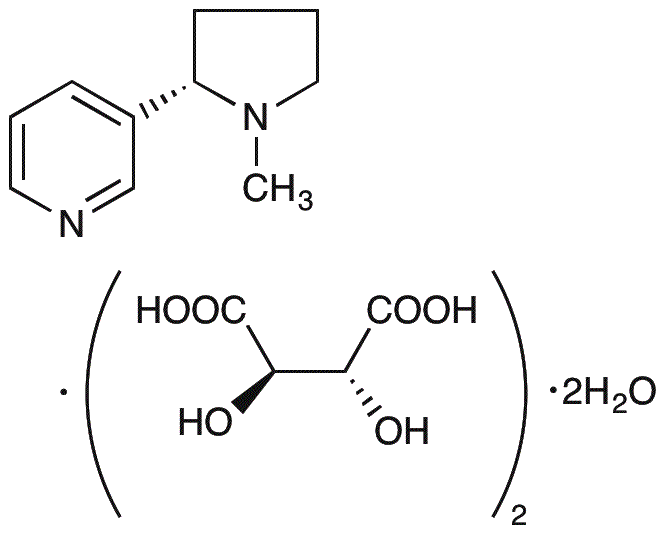Nicotine bi-L-(+)-tartrate dihydrate is widely utilized in research focused on:
- Pharmaceutical Development: This compound is often used in the formulation of smoking cessation products, helping to reduce withdrawal symptoms and cravings in individuals trying to quit smoking.
- Neuroscience Research: It serves as a valuable tool in studying the effects of nicotine on the central nervous system, aiding researchers in understanding addiction mechanisms and potential therapeutic targets.
- Analytical Chemistry: The compound is employed in various analytical techniques, such as chromatography, to assess nicotine levels in biological samples, ensuring accurate monitoring of exposure.
- Flavoring and Fragrance Industry: Due to its unique flavor profile, it is sometimes used in the development of flavoring agents for certain food products and beverages, appealing to consumers seeking specific taste experiences.
- Veterinary Medicine: It is also explored in veterinary applications, particularly in studies examining the effects of nicotine on animal behavior and physiology, contributing to better animal health management.
General Information
Properties
Safety and Regulations
Applications
Nicotine bi-L-(+)-tartrate dihydrate is widely utilized in research focused on:
- Pharmaceutical Development: This compound is often used in the formulation of smoking cessation products, helping to reduce withdrawal symptoms and cravings in individuals trying to quit smoking.
- Neuroscience Research: It serves as a valuable tool in studying the effects of nicotine on the central nervous system, aiding researchers in understanding addiction mechanisms and potential therapeutic targets.
- Analytical Chemistry: The compound is employed in various analytical techniques, such as chromatography, to assess nicotine levels in biological samples, ensuring accurate monitoring of exposure.
- Flavoring and Fragrance Industry: Due to its unique flavor profile, it is sometimes used in the development of flavoring agents for certain food products and beverages, appealing to consumers seeking specific taste experiences.
- Veterinary Medicine: It is also explored in veterinary applications, particularly in studies examining the effects of nicotine on animal behavior and physiology, contributing to better animal health management.
Documents
Safety Data Sheets (SDS)
The SDS provides comprehensive safety information on handling, storage, and disposal of the product.
Product Specification (PS)
The PS provides a comprehensive breakdown of the product’s properties, including chemical composition, physical state, purity, and storage requirements. It also details acceptable quality ranges and the product's intended applications.
Certificates of Analysis (COA)
Search for Certificates of Analysis (COA) by entering the products Lot Number. Lot and Batch Numbers can be found on a product’s label following the words ‘Lot’ or ‘Batch’.
*Catalog Number
*Lot Number
Certificates Of Origin (COO)
This COO confirms the country where the product was manufactured, and also details the materials and components used in it and whether it is derived from natural, synthetic, or other specific sources. This certificate may be required for customs, trade, and regulatory compliance.
*Catalog Number
*Lot Number
Safety Data Sheets (SDS)
The SDS provides comprehensive safety information on handling, storage, and disposal of the product.
DownloadProduct Specification (PS)
The PS provides a comprehensive breakdown of the product’s properties, including chemical composition, physical state, purity, and storage requirements. It also details acceptable quality ranges and the product's intended applications.
DownloadCertificates of Analysis (COA)
Search for Certificates of Analysis (COA) by entering the products Lot Number. Lot and Batch Numbers can be found on a product’s label following the words ‘Lot’ or ‘Batch’.
*Catalog Number
*Lot Number
Certificates Of Origin (COO)
This COO confirms the country where the product was manufactured, and also details the materials and components used in it and whether it is derived from natural, synthetic, or other specific sources. This certificate may be required for customs, trade, and regulatory compliance.


